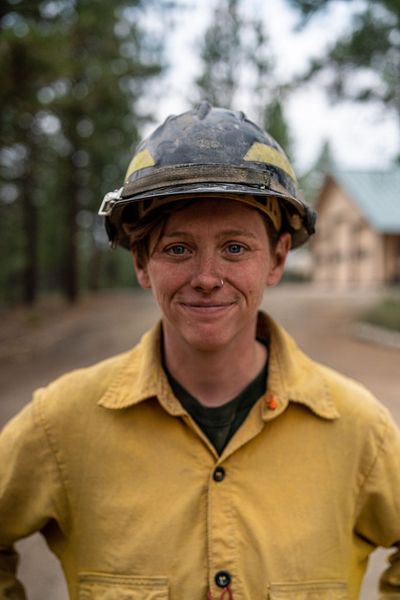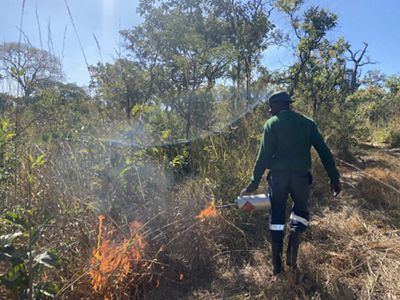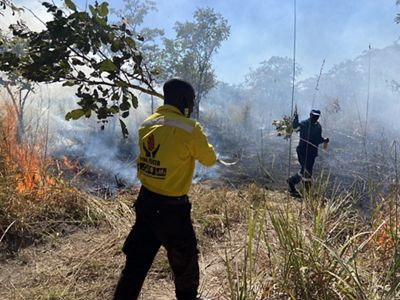From Oregon to Zambia: Sharing Fire Knowledge
Hear from TNC's Oregon fire program director, as they discuss their work with local partners on fire management practices at Kafue National Park.

We sat down for a conversation with Katie Sauerbrey, The Nature Conservancy's Fire Program Director in Oregon, shortly after their return from Kafue National Park in Zambia. Fire practitioners from the United States have been traveling to Zambia for more than 10 years to provide training, equipment and technical support to TNC staff and their partners in one of the largest national parks in the world. This trip was an opportunity to take stock of regional fire management and work with partners to begin to chart a path forward.
What stood out to you as similarities with your work in Oregon, and what was the most different?

Katie Sauerbrey: The primary ecosystem type in the Greater Kafue Ecosystem (GKE) is miombo woodlands, which are frequent-fire forests, burning every few years. The GKE is similar in size to West Virginia, and about two-thirds of that burns on an annual basis. Much like in Oregon and the Pacific Northwest, the people living in this frequent-fire ecosystem have to be fire-adapted, and many of the natural species in both areas depend on fire for well-being.
One thing that was different was people in Zambia, and the GKE specifically, view fire very differently than many folks in Oregon and the U.S. When I spoke with locals in Zambia and explained that I was there to help think through managing their wildfires with prescribed burning, they noted that they didn’t have a wildfire problem but, rather, that fire was just a part of the system. In many ways, they have learned to live with fire and experience fire as a part of normal life. Here in the U.S., we have spent the last century relegating fire as the enemy and something to be controlled. We could learn a lot from the way the Zambians I spoke with relate to fire.
Celebrating Cultural Burning Practices
Indigenous peoples are rekindling fire where U.S. policy suppressed it.
Read the ArticleWhat did you learn that you’ll apply to your work in Oregon?
KS: Zambia was a great reminder that we need people-centered solutions to many environmental challenges. For example, if communities in Zambia depend on fire to meet their basic needs, any conservation measures we put forward need to account for how folks are going to cook their food and keep their families warm. We need to remember that humans are one part of the ecosystems we inhabit and are not separate from it. So many life-forms on earth have adapted to fire cycles, yet in many ways humans have tried to shift and control natural fire processes and have thrown the system out of alignment.
Quote: Katie Sauerbrey
We must continue to put forth solutions to our conservation challenges that acknowledge humans and nature are not separate and that promote the well-being of both social and ecological systems.
Why is it important to share your knowledge? How will it help to advance work in Zambia (and beyond)?
KS: The challenges faced by Kafue National Park and the surrounding Game Management Areas are really unique. The challenge is less about how much of the area is burning and in large part really lies in the timing of the fires. The majority of their fires are burning in the hot and dry portion of their summer, which can result in the loss of miombo woodlands, and reduces available forage for wildlife. Due to the scale of the ecosystem there, the only really feasible way for them to reduce the amount of landmass burning during the hot/dry season is to do “early-burning” or prescribed fire prior to the hot dry season and create a mosaic of burnt areas to help limit the spread of fires in the undesirable time of year.

Fire management folks from the U.S., including myself, were helping the National Park Service and partners identify ways to increase their early burning with very limited resources on a vast landscape using innovative science to guide available resources to make the most impact. One thing I think was critically important was to not impress upon anyone that “fire is bad,” to avoid the stigma that we have in the U.S. around fire. Instead, we think creatively about how we live with and adapt to fire on the landscape.
How will you continue to contribute now that you’re back home?
KS: Once I returned to the U.S., I worked on a report to Kafue National Park and African Parks with recommendations on how to move forward with a revised fire management plan for the Greater Kafue Ecosystem. I incorporated information from meetings and workshops that I participated in while I was in Zambia, as well as information on new science-guided tools, such as remote sensing, to begin to lay a path for a new fire management and implementation plan.

What can be done today to be on a better path forward?
KS: We must continue to put forth solutions to our conservation challenges that acknowledge humans and nature are not separate and that promote the well-being of both social and ecological systems. We need to prioritize solutions benefiting people and nature, rather than pitting one against the other. This includes the recognition that fire is a natural part of a lot of Earth’s systems, and we need to adapt our ways of life to that reality.
How can someone reading this help?
KS: Continue to educate yourself about the role of fire within the systems that you live and recreate in. Learn about fire frequency and intensity within those places and be knowledgeable about how species depend on and adapt to fire. Advocate for the importance of fire in these places, and, most importantly, learn to live with fires when they burn within these ecosystems.
Stay Up to Date on Stories Like This One
Sign up to receive monthly conservation news and updates from Oregon. Get a preview of Oregon's Nature News email.